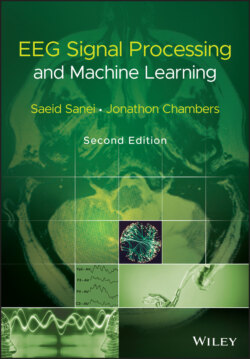Читать книгу EEG Signal Processing and Machine Learning - Saeid Sanei - Страница 56
3.5.2.2 The Harmon Neuron Model
ОглавлениеThe electronic realizations of the Hodgkin–Huxley model are very accurate in simulating the function of a single neuron. However, these circuits are often very complicated. Leon D. Harmon managed to develop a neuron model having a very simple circuit [60]. A circuit of the Harmon neuron model is given in Figure 3.17. The model is equipped with five excitatory inputs which can be adjusted. These include diode circuits representing various synaptic functions. The signal introduced at excitatory inputs charges the 0.02 μF capacitor which, after reaching a voltage of approximately 1.5 V, allows the monostable multivibrator, formed by transistors T1 and T2, to generate the action pulse. This impulse is amplified by transistors T3 and T4. The output of one neuron model may drive the inputs of a large number of the neighbouring neuron models.
Figure 3.17 The Harmon neuron model [60].
Figure 3.18 The Lewis model for simulation of the propagation of the action pulse [57].
